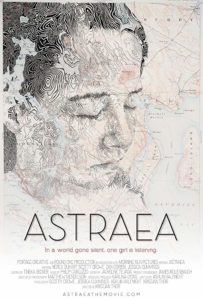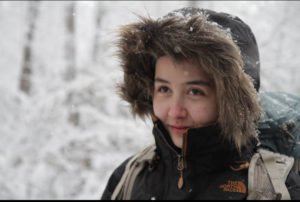Last June I blogged about my desire to read more hopeful science fiction. Since then I’ve talked about Woman on the Edge of Time, The Lovely Bones and Semiosis. Today I’m back with another recommendation for hopeful sci-fi, and this time it’s a film!
If you have recommendations for future instalments of this series, I’d sure like to hear them. Leave a comment below or send me message about it on Twitter.
Astraea
 Astraea is a 2016 film that is set in a slightly futuristic version of what used to be the United States. The main character, Astraea, is a young girl living in what’s left of human society after an epidemic killed off a huge percentage of the population. She’s convinced that their brother and grandmother are still alive, and tries to convince her older half-brother, Matthew, to travel around North America in search of them.
Astraea is a 2016 film that is set in a slightly futuristic version of what used to be the United States. The main character, Astraea, is a young girl living in what’s left of human society after an epidemic killed off a huge percentage of the population. She’s convinced that their brother and grandmother are still alive, and tries to convince her older half-brother, Matthew, to travel around North America in search of them.
Unlike a lot of post-apocalyptic societies, this one is pretty peaceful world. The human population is so small that it’s rare to run across another person in general, much less one who might have bad intentions.
I’ve reviewed several science fiction and fantasy movies for this site so far. This is the first truly hopeful one I’ve come across, so I thought I’d add it to the Hopeful Science Fiction reading (and now watching) list instead of writing a regular review for it.
Unfortunately, I wasn’t able to find photos of all of the characters like I normally do. This was an Indie film, so I’m guessing their fan base wasn’t large enough for them to have the resources or time to commit to such a thing. I was able to find photos of the two main characters, though, which is the most important thing.

Nerea Duhart as Astraea
Astraea is the protagonist, a teenage girl who may or may not have telepathic abilities. By the time she and her brother begin travelling to find their parents, there are very few living people left in North America. They spend the majority of their time with no company other than each other.

Scotty Crowe (left) as Matthew
Matthew is Astraea’s older brother. He is fiercely protective of his little sister. While he has doubts about whether or not their journey to find possible surviving relatives is a smart idea, he’s determined to travel with her and keep both of them safe.

Dan O’Brien as James
James is one of the few survivors of this plague that Astraea and Matthew met while travelling.After a tense misunderstanding during their first meeting, James and his wife, Callie, agree to give Astraea and Matthew food and shelter over the winter.
There Is Goodness In Our World
The first thing that struck me about this film was how ordinary life was for the characters despite the fact that they were technically living in a post-apocalyptic world. Their days were filled with going on food runs at the nearest grocery store, doing the occasional bit of hunting, keeping the fireplace burning, and finding ways to amuse themselves when those basic chores were finished. Their story happened during the winter, so their to-do lists were much shorter than they would be if the characters also needed to plant a garden or preserve food.
Honestly, I actually found the storytelling a little slow at times. It felt a lot like how real life unfolds. Most days are fairly ordinary and peaceful. Occasionally, someone might get into an accident, have an argument, or need medical treatment, but that is by the exception to the rule and it is always punctuated by other people doing everything they can to help.
This isn’t to say that the characters lived in perfect harmony all of the time. They had disagreements like any group of people living together are bound to do, but that was as far as the conflict went. Unlike violent shows like The Walking Dead, there were no roving bands of humans waiting to hurt the innocent folks they met on the road. The survivors were simply trying to stay alive through the winter.
Speaking of innocence, I was pleasantly surprised by how well all of the adults in Astraea’s life were able to protect her. She was seen as the child she was, and there was always someone around to make sure she had a nutritious meal to eat and a safe place to sleep. That isn’t common in this genre at all, and I found it refreshing. It wasn’t until I’d finished the scene that I looked up her name and realized that it is also the name of the Greek goddess of innocence. I’m sure the filmmakers did that on purpose. It was a wonderful reference that I’m glad I took the time to google.
Grief and Hope
All of the characters in this story lost people they loved in and shortly after the epidemic, so there were references to their deaths sprinkled in with the happier scenes. I appreciated the fact that the storytellers mixed these emotions together. There is hope after grief. You can miss someone who died recently or a long time ago and still find a reason to believe that tomorrow will be a brighter day.
In my quest to find hopeful science fiction, I keep circling back to stories that acknowledge the pain people experience during the course of a lifetime. There’s something immensely appealing to me about this sturdy kind of hope that thrives in difficult circumstances.
If you feel the same way, I highly recommend checking out this film.
Astraea is available on iTunes and Amazon Prime Video.

Huh. That looks really interesting. I’ll have to find a copy.
I think you’d love this film, Michael. Hope you’ll get to see it soon.
(Sorry about the delayed response here. I was on vacation recently and got behind on blog comments.)